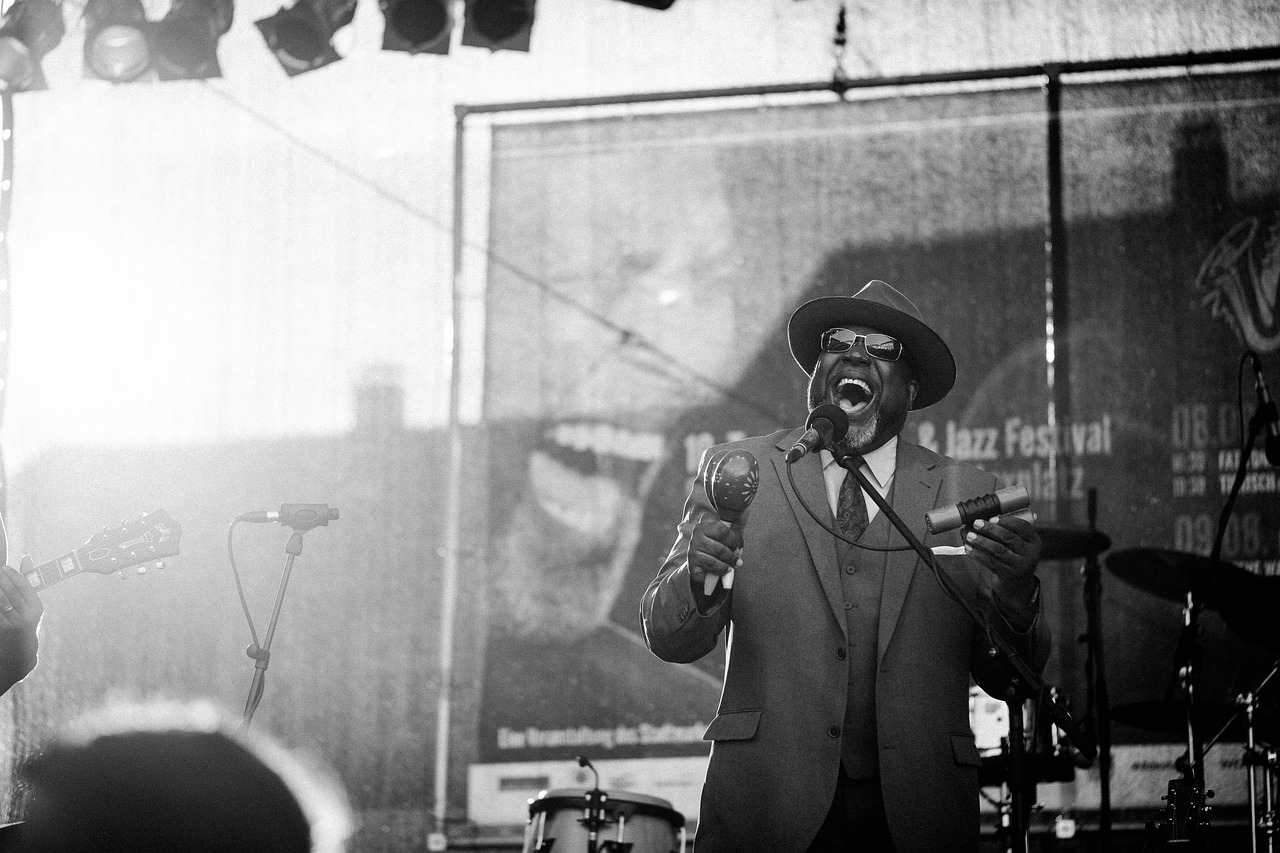A Journey Through Time: Reliving the Golden Era of Jazz

Welcome to the Golden Era of Jazz
Imagine a time when the air was filled with the smooth sounds of saxophones and the rhythmic beat of drums. The 1960s was a decade that resonated with the melodies of legendary jazz artists who shaped the genre and influenced music for generations to come. Ready to take a stroll down memory lane?
Key Figures of the 1960s Jazz Scene
Let’s explore some of the most iconic figures from this vibrant era:
- Duke Ellington – A master composer and bandleader whose influence extended far and wide.
- John Coltrane – A saxophonist known for his innovative approaches and profound spiritual themes in music.
- Billie Holiday – An emotive singer whose voice has captivated audiences, making her a timeless icon.
- Miles Davis – A trumpeter who redefined jazz with his unique styles and fusion of genres.
Jazz Styles That Defined the Era
Each artist contributed to distinct styles that characterized the sound of the 60s. Here are some notable styles:
- Bebop – Fast-paced and complex, characterized by intricate melodies.
- Modal Jazz – A style that uses musical modes rather than chords as a harmonic framework.
- Free Jazz – An avant-garde movement that emphasized improvisation and the breaking of traditional structures.
Memorable Albums to Relive
Let’s take a look at some influential albums from the 1960s that you might remember:
| Artist | Album | Release Year |
|---|---|---|
| John Coltrane | A Love Supreme | 1965 |
| Miles Davis | Kind of Blue | 1959 |
| Billie Holiday | Lady in Satin | 1958 |
| Duke Ellington | Far East Suite | 1966 |
Interactive Reflection
Take a moment to reflect on your favorite jazz memories from the 60s. Perhaps you attended a live performance or enjoyed a quiet evening listening to records. Here are some prompts to guide your thoughts:
- What was your favorite jazz club or venue during that time?
- Who were your favorite artists, and what songs moved you the most?
- How did jazz music influence your life or the lives of those around you?
Conclusion: Keeping the Jazz Spirit Alive
As we reminisce about the golden era of jazz, let us keep the spirit alive in our hearts and share these stories with younger generations. The legacy of the 1960s jazz artists continues to inspire and connect us through their timeless music.
Melodies that Moved a Generation: The Icons of 1960s Jazz

As we take a stroll down memory lane, the 1960s emerge as a vibrant tapestry of sound, pulsating with the rhythms of jazz. This era was marked by the emergence of legendary artists whose melodies not only defined a musical genre but also captured the spirit of a generation. In this interactive journey, let us explore the icons of 1960s jazz, their signature styles, and the lasting impact of their music.
Key Figures in 1960s Jazz
| Artist | Signature Style | Notable Works |
|---|---|---|
| John Coltrane | Avant-garde, modal jazz | “A Love Supreme”, “Giant Steps” |
| Miles Davis | Bebop, cool jazz | “Kind of Blue”, “Sketches of Spain” |
| Bill Evans | Modal jazz, impressionistic | “Sunday at the Village Vanguard”, “Explorations” |
| Ella Fitzgerald | Vocal jazz, scat singing | “Ella in Berlin”, “Ella Fitzgerald Sings the Duke Ellington Songbook” |
The Cultural Impact of Jazz
The 1960s was not just about music; it was a cultural revolution. Jazz became a voice for civil rights, a soundtrack for change, and a medium for expression. Artists like John Coltrane and Ella Fitzgerald used their platforms to address social issues, making their music resonate deeply with the struggles of the time.
Interactive Listening Experience
As you reflect on these iconic artists, consider revisiting some of their timeless tracks. Here are a few suggestions:
“A Love Supreme” by John Coltrane – A spiritual suite that transcends time.
“So What” by Miles Davis – A cool jazz piece that defines the genre.
“Waltz for Debby” by Bill Evans – A melodic exploration of beauty and simplicity.
“Summertime” by Ella Fitzgerald – A classic that showcases her extraordinary vocal range.
The melodies of the 1960s jazz icons continue to inspire and evoke emotions, reminding us of the power of music to connect generations. Take a moment to listen, reflect, and celebrate the artistry that shaped an era.
Rhythms of Resilience: How Jazz Reflects the Spirit of the 60s

The 1960s: A Decade of Change
The 1960s was a time of profound transformation in society, politics, and culture. As you reminisce about this vibrant era, think about how jazz music served as both a mirror and a catalyst for the changes happening around the world. The beats and melodies of jazz became a powerful expression of resilience and hope.
The Birth of New Sounds
During the 60s, jazz artists experimented with different styles, pushing the boundaries of traditional music. Innovations like free jazz emerged, allowing musicians to explore improvisation without the constraints of established forms. Can you remember the first time you heard the unique sounds of artists like Ornette Coleman or John Coltrane? Their music was a reflection of the social upheaval and a call for freedom.
Jazz and Civil Rights
Jazz was not just a genre; it became the soundtrack of the Civil Rights Movement. Artists like Max Roach and Abbey Lincoln used their music to speak out against racial injustice. Think back to the powerful songs that resonated with the struggles and triumphs of the time. Can you feel the passion in their performances?
The Influence of Iconic Artists
Legends like Duke Ellington, Miles Davis, and Billie Holiday left an indelible mark on jazz during this era. Their contributions shaped the genre and inspired countless musicians. How did their music impact your life or the lives of those around you? Reflect on the moments when jazz brought people together, transcending barriers.
A Lasting Legacy
Even today, the spirit of the 60s lives on in jazz. The resilience showcased through the music continues to inspire new generations of artists. As you listen to modern jazz, think about how the rhythms of the past echo in the present. What feelings or memories does it evoke for you?
Join the Conversation
Let’s celebrate the enduring power of jazz. Share your favorite memories or songs from the 1960s. How has jazz influenced your understanding of resilience and hope? Your stories are part of the rich tapestry of jazz history, and we invite you to join in the discussion.
Unforgettable Performances: The Concerts that Shaped Jazz History
Introduction to Jazz Concerts of the 1960s
The 1960s were a pivotal decade for jazz, a time when artistry and expression reached new heights. This era birthed unforgettable performances that not only defined the genre but also captivated audiences worldwide. Let’s take a walk down memory lane and revisit some of the most iconic concerts that shaped jazz history.
The Newport Jazz Festival: A Celebration of Talent
One of the most significant events in the jazz calendar was the Newport Jazz Festival. Held annually in Newport, Rhode Island, this festival became a launching pad for many legendary artists. In 1956, a performance by Duke Ellington set the stage for future generations. His innovative arrangements and the powerful presence of his band created an atmosphere of pure magic.
Key Performances That Made History
- 1965: Miles Davis at the Fillmore – Miles Davis brought a new sound to jazz with his electric performances. His concert at the Fillmore was a turning point, merging jazz with rock and attracting a new audience.
- 1964: John Coltrane’s A Love Supreme – This concert was not just a performance; it was a spiritual journey. Coltrane’s deep connection to his music resonated with everyone present.
- 1967: Ella Fitzgerald at the Apollo Theater – The First Lady of Song delivered a stunning performance that highlighted her incredible vocal range and improvisational skills, leaving the audience in awe.
The Impact of Live Performances
Live performances during this decade were more than just concerts; they were experiences that shaped the future of music. The interaction between the artists and the audience created an electric atmosphere that resonated long after the last note was played.
Legacy of the 1960s Jazz Concerts
The concerts of the 1960s left an indelible mark on the jazz landscape. The genre evolved, influenced by the innovative styles introduced during this time. Many of the artists from this era remain influential, paving the way for contemporary musicians.
What are your memories of jazz concerts from the 1960s? Who were your favorite artists? Share your stories and let’s reminisce about the unforgettable performances that shaped jazz history together.
Voices of the Past: Legendary Artists Who Defined Jazz for the Ages
Introduction to Jazz Legends
As we journey through the vibrant landscapes of jazz in the 1960s, we encounter a rich tapestry woven with the sounds of legendary artists. This era was not only pivotal but also transformative, echoing the sentiments of a generation through its unique rhythms and melodies.
Let us explore some of the iconic artists who left an indelible mark on the world of jazz:
- John Coltrane – Known for his innovative improvisations, Coltrane took jazz to new heights with his spiritual explorations and complex compositions.
- Miles Davis – A true pioneer, Davis constantly evolved his style, influencing countless musicians with his cool jazz and modal jazz approaches.
- Ella Fitzgerald – The ‘First Lady of Song,’ Fitzgerald’s impeccable vocal technique and scat singing set her apart as one of the greatest jazz vocalists.
- Billie Holiday – With her emotive voice and poignant lyrics, Holiday brought deep emotional resonance to jazz, making her a timeless icon.
- Thelonious Monk – Monk’s unique style and eccentric compositions challenged the conventions of jazz, establishing him as a revolutionary figure.
The Impact of Their Music
The contributions of these artists were not just musical; they shaped culture and society. Their sounds resonated during times of change, reflecting the struggles and triumphs of the era.
Take a moment to reflect on how these artists influenced your life:
- Which artist’s music resonates with you the most?
- Can you recall a specific memory associated with their songs?
- How do you feel their legacy lives on today?
The legendary artists of the 1960s created a legacy that continues to inspire and influence generations. Their voices remain a testament to the power of jazz, echoing the elegance of the past while paving the way for the future.
Swinging Into the Spotlight: The Rise of Jazz Legends in the 1960s
Introduction to the Jazz Renaissance
Imagine a decade where the sound of trumpets and saxophones filled the air, where improvisation was an art form, and where the rhythms made you want to tap your feet. The 1960s were a vibrant time for jazz, marking the emergence of some legendary artists who changed the landscape of music forever.
The Cultural Context of the 1960s
As the world around them shifted with social changes and the civil rights movement, jazz musicians captured these sentiments in their music. It became a voice for the unheard, a canvas for expressing both joy and struggle.
Iconic Artists of the Decade
Let’s explore some of the giants of jazz who rose to prominence during this exciting decade:
- John Coltrane: Known for his innovative style and spiritual quest, Coltrane took jazz to new heights with albums like A Love Supreme.
- Miles Davis: A pioneer of modal jazz, Davis captivated audiences with his cool demeanor and groundbreaking albums such as Kind of Blue.
- Ella Fitzgerald: The First Lady of Song, Ella’s voice soared over the jazz landscape, enchanting listeners with her incredible range and scat singing.
- Thelonious Monk: With his unique piano style and compositions, Monk’s eccentricity and brilliance made him a standout figure of the era.
The Influence of Jazz Festivals
The rise of jazz festivals in the 1960s significantly contributed to the genre’s popularity. Events like the Monterey Jazz Festival and the Newport Jazz Festival showcased these legends, bringing jazz to the forefront and introducing new audiences to their captivating performances.
Impact on Future Generations
The legacy of the jazz legends of the 1960s is undeniable. Their innovative techniques and musical explorations paved the way for future artists across various genres. Today, their influence can be seen in the works of contemporary musicians who continue to draw inspiration from these icons.
Think back to the first time you heard a jazz song that made your heart race. What was it about that moment that resonated with you? Was it the rhythm, the melody, or perhaps the emotions it stirred within? These artists not only shaped a genre but also created personal connections through their music.
As we reminisce about the golden age of jazz in the 1960s, let us celebrate the artists who made it possible. Their contributions are not just a part of music history; they are a part of our lives, echoing elegance through every note.
The Soul of Jazz: Exploring the Heartfelt Stories Behind the Music
Jazz is more than just a genre; it’s a rich tapestry of emotion, culture, and history. The 1960s marked a transformative era for jazz, characterized by groundbreaking artists who infused their personal stories into their music. Let’s take a journey through this vibrant decade, discovering the heartfelt tales that shaped the sound of jazz.
1. The Rise of Personal Expression
In the 1960s, jazz musicians began to delve deeper into their personal experiences, creating music that resonated with the struggles and triumphs of their lives. These artists used their instruments as a means of storytelling, weaving narratives that spoke of love, loss, and hope.
2. Iconic Artists and Their Stories
| Artist | Notable Work | Personal Story |
|---|---|---|
| John Coltrane | A Love Supreme | Coltrane’s spiritual awakening fueled his music, reflecting his quest for meaning. |
| Bill Evans | Waltz for Debby | Evans’ introspective style was influenced by his own battles with depression. |
| Ella Fitzgerald | Ella in Berlin | Fitzgerald’s journey from poverty to stardom is a testament to her resilience. |
| Miles Davis | Kind of Blue | Davis’ innovative spirit often stemmed from his tumultuous personal life. |
3. The Power of Collaboration
Many legendary jazz pieces emerged from collaborations between artists. These partnerships often brought together different backgrounds and styles, creating a unique blend that pushed the boundaries of jazz. For instance, the collaboration between Coltrane and Davis on Kind of Blue produced one of the most influential albums in jazz history.
4. The Cultural Impact of Jazz
Jazz in the 1960s was not just about music; it was a cultural movement. The civil rights movement influenced many jazz artists, who used their platforms to advocate for change. Songs became anthems for freedom, and performances were often political statements.
5. Interactive Reflection
As we reflect on these stories, consider the following questions:
What does jazz mean to you?
Can you recall a moment when jazz music touched your heart?
Which artist’s story resonates with you the most?
Engage with the music and let the stories behind the notes inspire you. Jazz is a shared experience—a way to connect with the past while creating new memories.
In Their Own Words: Personal Reflections from Jazz Greats of the Era
Echoes of a Golden Age
The 1960s were a transformative time for jazz, characterized by innovation, rebellion, and profound musical expression. This era was not just about the music; it was about the artists who shaped it. Let’s take a moment to immerse ourselves in the reflections of some legendary figures from this vibrant period.
Louis Armstrong: The Heart of Jazz
“What we play is life.” Louis Armstrong, often called Satchmo, believed that jazz was a reflection of the human experience. His infectious spirit and improvisational genius made him a beloved figure. “I don’t care how people dress or what they look like, as long as they enjoy the music,” he shared, emphasizing the universal connection jazz provides.
John Coltrane: Seeking the Divine
“My music is the spiritual expression of what I am — my faith, my knowledge, my being.” Coltrane was on a quest for deeper meaning, both in life and in music. He once stated, “I’m not a genius. I’m just a man who loves jazz.” His humility belied his extraordinary talent, and his work resonated with those seeking solace and enlightenment.
Duke Ellington: The Maestro of Melodies
“There are no wrong notes; some are just more right than others.” Duke Ellington was a master of composition and arrangement. He believed that every performance was a conversation. “I merely took the energy it takes to pout and wrote some blues,” he reflected, showing how he transformed pain into art.
Billie Holiday: The Voice of Emotion
“I never had a chance to play with a band. I was always a soloist.” Billie Holiday’s unique voice conveyed profound emotion that transcended words. She said, “If I could have a wish, it would be to sing like I felt.” Her struggles and triumphs were embodied in every note she sang, making her an enduring symbol of resilience.
Miles Davis: The Innovator
“It’s not about the notes you play, but the space you leave.” Miles Davis was known for pushing boundaries and experimenting with styles. He explained, “I’m always thinking about what I’m going to do next, but I can’t control it.” His openness to evolution in jazz illuminated new paths for future generations.
Count Basie: The Swing Architect
“It’s all about the rhythm.” Count Basie brought swing to the forefront, believing it was the heartbeat of jazz. His philosophy was simple: “If you don’t have rhythm, you don’t have anything.” He encouraged young musicians to find their unique groove and let it shine.
Conclusion: A Timeless Legacy
The reflections of these legendary artists remind us that jazz is more than music; it is a profound expression of life’s complexities. As we listen to their stories, we not only hear their echoes but also feel the elegance of their legacy. Let their words inspire us to carry forward the spirit of jazz, enriching our lives and those around us.
A Tapestry of Sound: The Influences that Crafted 1960s Jazz
Exploring the Roots of Jazz
Jazz, a genre that resonates with rich history and profound emotion, evolved significantly during the 1960s. This era was marked by a fusion of various musical influences, creating a vibrant tapestry of sound. Let’s embark on this journey together, shall we?
The Impact of Cultural Movements
As we delve deeper, we find that the civil rights movement played a pivotal role in shaping the jazz scene. Artists like John Coltrane and Max Roach infused their music with messages of resistance and hope. Can you recall any particular songs that stirred feelings of empowerment?
Exploration of New Sounds
During this transformative decade, musicians began to experiment with modal jazz and free jazz. The likes of Bill Evans and Ornette Coleman pushed boundaries, inviting listeners to experience improvisation in unparalleled ways. Have you ever felt the thrill of a spontaneous jazz performance?
Global Influences
Jazz in the 1960s was not confined to American borders. The infusion of Latin rhythms and African beats enriched the genre further. Chick Corea and Weather Report explored these sounds, creating a bridge between cultures. What are your thoughts on the blend of different musical traditions?
Women in Jazz
The 1960s also saw a rise in recognition for female jazz artists. Legends such as Ella Fitzgerald and Billie Holiday paved the way for future generations. Their contributions were not just musical but also cultural. How do you think their presence changed the landscape of jazz?
The Role of Technology
Technological advancements, such as the introduction of multi-track recording, allowed artists to experiment with sound in innovative ways. This evolution played a significant role in shaping the jazz recordings of the time. Have you ever marveled at how technology has transformed music?
Conclusion: The Legacy of 1960s Jazz
The 1960s jazz scene was a dynamic blend of influences, showcasing the resilience and creativity of its artists. As we reflect on this era, let us celebrate the legends and the sounds they created. What does jazz mean to you today, and how has it influenced your life?
Legacy of the Legends: How 1960s Jazz Continues to Inspire Today
Have you ever found yourself swaying to the gentle rhythms of a jazz tune? The music of the 1960s holds a special place in the hearts of many, especially for those who lived through its golden era. This decade was not just about melodies; it was about innovation, emotion, and expression.
The Pioneers of Jazz
Let’s take a moment to remember some of the legendary artists who defined this remarkable period. Artists like John Coltrane, Duke Ellington, and Billie Holiday left indelible marks on the genre. Their compositions and performances were not merely songs; they were stories that resonated deeply with the times.
The Impact of 1960s Jazz on Today’s Music
Now, you might wonder, how does the jazz of the 1960s impact the music we listen to today? The answer lies in its influence. Modern musicians often draw inspiration from the complex harmonies and improvisational styles that were perfected during this era. For instance, artists like Kamasi Washington and Esperanza Spalding channel the spirit of their predecessors, bridging the gap between generations.
Jazz as a Source of Inspiration
Think back to your favorite jazz piece. How does it make you feel? The emotional depth of 1960s jazz continues to inspire countless artists across various genres. The raw emotions conveyed through the music can be felt in hip-hop, rock, and even pop today. It’s fascinating to see how these influences manifest in the songs that resonate with the youth of today.
Let’s engage in a little reflection. Take a moment to think about your favorite jazz artist from the 1960s:
What was it about their music that captivated you?
Do you see traces of their influence in contemporary music?
Consider sharing your thoughts with friends or family. Discussing these experiences can foster a deeper appreciation for the music that has shaped our lives.
The Legacy Lives On
As we delve deeper into the legacy of 1960s jazz, we realize that it is not just a relic of the past; it is a living, breathing entity that continues to evolve. The vibrant sounds and innovative styles from that era remind us that music is a universal language that transcends time.
So, let the echoes of elegance resonate within you. Whether you’re revisiting classic albums or discovering new artists inspired by the legends of the past, remember that the spirit of 1960s jazz will always remain a part of our musical tapestry.
